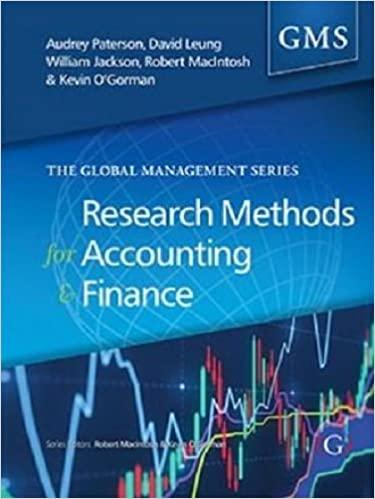Question
In January 2011, InTech Co. pays $1,350,000 for a tract of land with two buildings. It plans to demolish Building A and build a new
In January 2011, InTech Co. pays $1,350,000 for a tract of land with two buildings. It plans to demolish Building A and build a new shop in its place. Building B will be a company office; it is appraised at $472,770, with a useful life of 15 years and a $90,000 salvage value. A lighted parking lot near Building B has improvements (Land Improvements B) valued at $125,145 that are expected to last another six years with no salvage value. Without the buildings and improvements, the tract of land is valued at $792,585. The company also incurs the following additional costs.
Cost to demolish Building A..... $117000
Cost of additional land grading..... $172500
Cost to construct new building (Building C) having a useful life of 20 years and a $295500 salvage value..... $1356000
Cost of new land imporvements (Land Improvements C) near building C, having a 10 year useful life and no salvage value.... $101250
I need to do the following with this information but have no clue how to do formulas in Excel!! She provided us with the excel worksheet.
| Computer Problem # 2 | ||||||||
| 1. | Read Problem 10-2B on page 428 of your textbook. (PASTED ABOVE) | |||||||
| 2. | Complete the 4 tabs of this excel workbook as follows: | |||||||
| Allocation of Costs | ||||||||
| - input into column C the appropriate appraised values of the assets listed. | ||||||||
| - set up a formula in cell C11 to add the total appraised values. | ||||||||
| - set up formulas in cells E7-E9 to calculate each asset's % of total value. | ||||||||
| - set up a formula in cell E11 to add the total %, make sure this total is 1.00. | ||||||||
| - set up formulas in cells G7-G9 to apportion the cost for each asset based on | ||||||||
| it's % of the total value. | ||||||||
| - set up a formula in cell G11 to add the total apportioned costs of each asset. | ||||||||
| Make sure this total is 1,350,000. | ||||||||
| Table | ||||||||
| - input the apportioned costs calculated in the previous tab under the respective | ||||||||
| column for land, building B and land improvements B. | ||||||||
| - input the costs of demolition, land grading, new building C and new land | ||||||||
| improvements C under their respective columns. | ||||||||
| - set up formulas in cells C10, E10, G10, I10 and K10 to add the total cost of | ||||||||
| each asset. | ||||||||
| Depreciation | ||||||||
| - input the total cost calculated in the previous tab for each of the 4 assets listed. | ||||||||
| - input the salvage values for each asset, if applicable. | ||||||||
| - set up formulas in cells G7, G9, G11 and G13 to calculate the depreciable cost | ||||||||
| for each asset. | ||||||||
| - input the useful life (numeric value only) for each asset. | ||||||||
| - set up formulas in cells K7, K9, K11 and K13 to calculate the annual depreciation | ||||||||
| expense for each asset, using the SL method. | ||||||||
| Journal Entries | ||||||||
| - input journal entries to record (1) the purchase of all 5 assets on 1/1/11 and (2) the | ||||||||
| depreciation expense for the 12 months ended 12/31/11. Input a separate journal | ||||||||
| entry to record depreciation expense for each asset. | ||||||||
| - for each journal entry, directly input the amounts in the debit column only and set up | ||||||||
| formulas for each credit entry. | ||||||||
| - leave 2 blank rows between each journal entry. | ||||||||
| - you should end up with 5 journal entries in total. | ||||||||
| - for each journal entry, input the names of the accounts under either column C or D | ||||||||
| as needed, not both. | ||||||||
| - likewise, input the amounts of your entries under either column F or G as needed, | ||||||||
| not both. | ||||||||
Step by Step Solution
There are 3 Steps involved in it
Step: 1

Get Instant Access to Expert-Tailored Solutions
See step-by-step solutions with expert insights and AI powered tools for academic success
Step: 2

Step: 3

Ace Your Homework with AI
Get the answers you need in no time with our AI-driven, step-by-step assistance
Get Started


